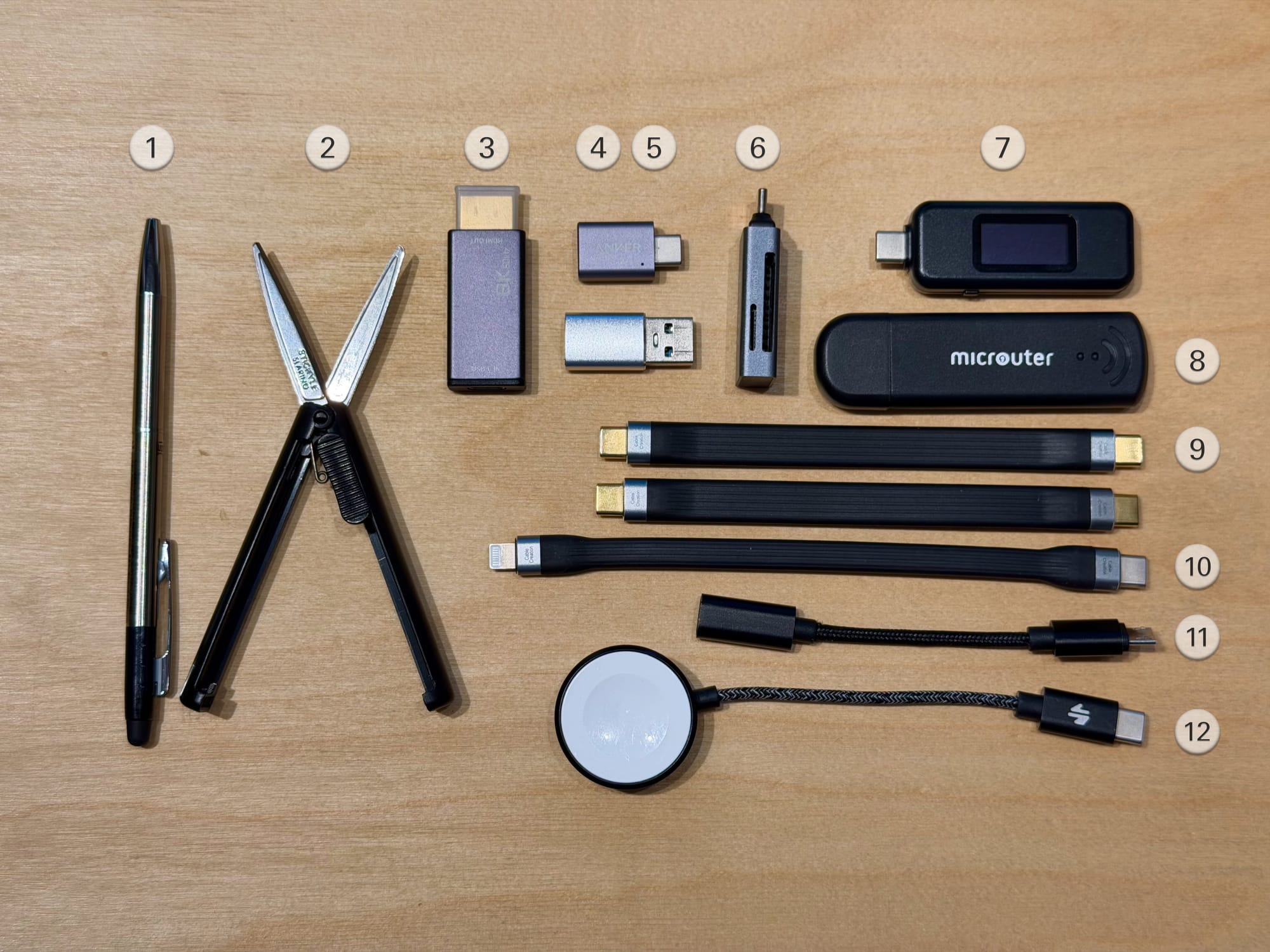Flat Lay Friday: My tech kit
In the EDC community, "Flat Lay Friday" is an opportunity to capture the contents of your daily carry in a neatly organized photo. I'm not an EDC enthusiast (my rather boring "carry" consists solely of a wallet, car keys, and iPhone; no fancy knives or titanium fidget toys to be found) but I have spent a long time crafting the perfect tech kit and I thought I'd share it.
I actually have two identical kits. One has a permanent place in my laptop bag (DSPTCH's small Dyneema slingpack), and the other floats between a sling, suitcase, totebag, or whatever I happy to have with me on a given day. It's optimized for size, fitting (almost) everything I need into a small pen case.

- Pilot FriXion Ball Slim Biz Gel Pen
FriXion is Pilot's proprietary erasable pen, which—as the name suggests—erases with friction. I also appreciate that the point is super fine at 0.38 mm. Every few months I consider switching to a LAMY Pico, but so far the Pilot pen has kept its spot. - Sun-Star Stickyle Slarino Scissors
If I'm honest, these are lousy scissors. But they are super compact when folded, a reasonable size when unfolded, and have yet to get flagged by TSA. They're more than fine for cutting average-weight paper, stumble a bit on string and thicker papers, but are still better than nothing at all. - USB-C to HDMI adapter
I used to carry the more common style of HDMI dongle which had a USB-C male plug on one end, and a female HDMI on the other. But that requires you carry an HDMI cable with you, which are often bulky and not useful in other contexts. This adapter flips the script by plugging directly into the HDMI port of your screen, and then running through to your device via a longer USB-C cable. You have to use an adequate USB-C cable, but all my USB-C cables, as you'll see below, are 3.1 Gen 2 or greater. - Anker USB-A to USB-C adapter
This adapter allows you to plugin USB-A devices into USB-C ports. Simple as that. - USB-C to USB-A adapter
Plugging USB-C devices into USB-A ports is not technically allowed by the USB specification, which is why this adapter is unbranded. I am not often plugin devices into USB-C ports for data transfer, so this adapter really only serves one purpose: allowing me to charge off old USB-A charging ports on airplanes, charging stations, etc. - Anker SD/MicroSD to USB-C card reader
Does what it says on the tin. Used mostly for flashing MicroSD cards for my Raspberry Pi, which also means it's currently a candidate for removal from the travel kit; the Raspberry Pi never leaves my server rack. - Plugable USB-C power meter
One of those devices that doesn't get much use, but is incredibly valuable when it is needed. The primary use-case is validating the power output of vaguely sketchy USB-C devices, or for confirming safe voltage levels when using the also-sketchy USB-C to USB-A adapter (#5). - GL.iNet USB-A Microuter
The microuter is an incredible product: a slightly-larger-than-a-flash-drive b/g/n wifi router and repeater. Any time I'm staying somewhere longer than a few nights, the Microuter comes out and gets set up to repeat the hotel or Airbnb wifi on my own network. The SSID and authentication is the same as my home network, so devices connect quickly, and Wireguard is enabled to tunnel traffic through my home router. Unfortunately, it's discontinued and nearly impossible to find, so I plan to run mine to the ground. - USB-C to USB-C 3.1 Gen 2 cables (2x)
Short USB-C-to-C cables, in the 3.1gen2 standard. More than fast enough for my needs (and truthfully, these are usually only used for power). - USB-C to Lightning cable
Another candidate to exit the kit, this has stuck around only because my work iPhone still charges over Lightning. As soon as the work phone is replaced, this cable will make its way to the great "odds-and-ends cables" box in the sky. - USB-C to Micro-USB cable
The final candidate to leave the kit, this converts from a USB-C male end to a Micro-USB male end. It was originally intended to power a small Blink camera that I bring if we're travelling for a longer period of time with our dog, and I want to make sure he's not getting up to trouble in the hotel room while we're out (spoiler: he never gets up to trouble). However, the newest Blink mini camera now supports USB-C, rendering it moot. It stays for now, just in case, but will probably exit the kit soon enough. - Apple Watch charger
I don't wear my Apple Watch too often at home, but I do tend to bring it for longer trips and need a place to charge it. The fact that my AirPods Pro, which never leave my side, also charge via Apple Watch is a nice bonus.
Bonus Items
There are two other items I always travel with: a 1 meter USB-C-to-C cable (3.1 Gen 2, of course) and the Nomad 65W USB-C AC charger. That longer USB-C cable is essential for laptop charging and also makes the HDMI dongle feasible. The Nomad charger is the smallest 65W charger I've found, and has been impressively reliable.